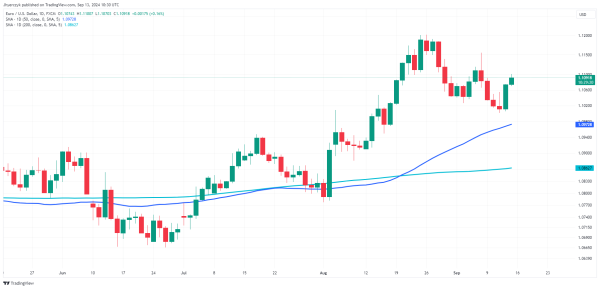Will Fed’s Gradual Cuts and ECB Caution Lead to EUR/USD Volatility?
Impact of Fed and ECB Rate Cut Strategies on EUR/USD: A Delicate Balance
The diverging paths of interest rate policies between the Federal Reserve (Fed) and the European Central Bank (ECB) are poised to significantly influence the EUR/USD exchange rate in the coming months. Recent developments have highlighted a growing disparity in approach: while traders anticipate aggressive rate cuts from the Fed, the ECB has dampened expectations for immediate easing.

This contrast in monetary strategies, coupled with varying economic outlooks and inflation concerns on both sides of the Atlantic, creates a complex landscape for currency markets. As the Fed grapples with persistent inflation despite recent improvements, and the ECB navigates sluggish growth in the Eurozone, the pace and timing of rate cuts by both central banks will be crucial in shaping the near-term direction of the EUR/USD pair.
Fed Cuts Aggressively, ECB Stays Cautious: If the Fed cuts rates rapidly while the ECB holds off, the U.S. dollar would likely weaken. This could boost the euro as capital shifts to higher-yielding Eurozone assets. However, a stronger euro might tighten Eurozone financial conditions, complicating ECB’s economic stimulation efforts.- Both Cut Rates Slowly: If both banks opt for slow, cautious cuts, the impact on EUR/USD could be muted. The exchange rate might trade in a narrow range, with neither currency having a distinct yield advantage. The euro could face pressure if Eurozone growth remains sluggish compared to the U.S.
- Fed Cuts Slowly, ECB Accelerates Easing: If the Fed slows its rate-cutting due to inflation while the ECB accelerates cuts, EUR/USD could trend downward. A slower Fed could keep the U.S. dollar strong, while ECB cuts would signal concerns about Eurozone growth, weighing on the euro.
- Fed Cuts Quickly, ECB Stays on Hold: If the Fed surprises with aggressive cuts while the ECB maintains caution, the euro could strengthen significantly. However, a stronger euro would challenge Eurozone growth, potentially forcing the ECB to respond with rate cuts.
- ECB Slow to Ease, Eurozone Economy Falters: If the ECB is too slow in cutting rates while the Eurozone economy deteriorates, the euro could face downward pressure regardless of Fed action. This scenario might lead to a loss of confidence in the ECB’s ability to support growth.
Outlook for EUR/USDVolatile with Bearish Bias
EUR/USD is likely to see volatility in the near term, with diverging rate paths as a key driver. If the Fed cuts more aggressively than the ECB, the euro may gain, but ECB hesitation could cap the euro’s upside. The outlook is tilted slightly bearish due to the ECB’s cautious approach and the Eurozone’s weak growth prospects, which may limit gains against a U.S. dollar supported by stronger fundamentals.